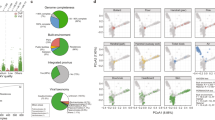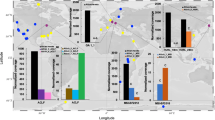Abstract
The human oral cavity has an indigenous microbiota known to include a robust community of viruses. Very little is known about how oral viruses are spread throughout the environment or to which viruses individuals are exposed. We sought to determine whether shared living environment is associated with the composition of human oral viral communities by examining the saliva of 21 human subjects; 11 subjects from different households and 10 unrelated subjects comprising 4 separate households. Although there were many viral homologues shared among all subjects studied, there were significant patterns of shared homologues in three of the four households that suggest shared living environment affects viral community composition. We also examined CRISPR (clustered regularly interspaced short palindromic repeat) loci, which are involved in acquired bacterial and archaeal resistance against invading viruses by acquiring short viral sequences. We analyzed 2 065 246 CRISPR spacers from 5 separate repeat motifs found in oral bacterial species of Gemella, Veillonella, Leptotrichia and Streptococcus to determine whether individuals from shared living environments may have been exposed to similar viruses. A significant proportion of CRISPR spacers were shared within subjects from the same households, suggesting either shared ancestry of their oral microbiota or similar viral exposures. Many CRISPR spacers matched virome sequences from different subjects, but no pattern specific to any household was found. Our data on viromes and CRISPR content indicate that shared living environment may have a significant role in determining the ecology of human oral viruses.
Similar content being viewed by others
Log in or create a free account to read this content
Gain free access to this article, as well as selected content from this journal and more on nature.com
or
References
Andersson AF, Banfield JF . (2008). Virus population dynamics and acquired virus resistance in natural microbial communities. Science 320: 1047–1050.
Angly F, Rodriguez-Brito B, Bangor D, McNairnie P, Breitbart M, Salamon P et al (2005). PHACCS, an online tool for estimating the structure and diversity of uncultured viral communities using metagenomic information. BMC Bioinformatics 6: 41.
Angly FE, Felts B, Breitbart M, Salamon P, Edwards RA, Carlson C et al (2006). The marine viromes of four oceanic regions. PLoS Biol 4: e368.
Bachrach G, Leizerovici-Zigmond M, Zlotkin A, Naor R, Steinberg D . (2003). Bacteriophage isolation from human saliva. Lett Appl Microbiol 36: 50–53.
Barrangou R, Fremaux C, Deveau H, Richards M, Boyaval P, Moineau S et al (2007). CRISPR provides acquired resistance against viruses in prokaryotes. Science 315: 1709–1712.
Bhaya D, Davison M, Barrangou R . (2011). CRISPR-Cas Systems in Bacteria and Archaea: Versatile Small RNAs for Adaptive Defense and Regulation. In: Bassler BL, Lichten M, Schupbach G, (eds) Annual Review Genetics Vol 45. Annual Reviews: Palo Alto, pp 273–297.
Bik EM, Eckburg PB, Gill SR, Nelson KE, Purdom EA, Francois F et al (2006). Molecular analysis of the bacterial microbiota in the human stomach. Proc Natl Acad Sci USA 103: 732–737.
Bik EM, Long CD, Armitage GC, Loomer P, Emerson J, Mongodin EF et al (2010). Bacterial diversity in the oral cavity of 10 healthy individuals. ISME J 4: 962–974.
Breitbart M, Haynes M, Kelley S, Angly F, Edwards RA, Felts B et al (2008). Viral diversity and dynamics in an infant gut. Res Microbiol 159: 367–373.
Breitbart M, Hewson I, Felts B, Mahaffy JM, Nulton J, Salamon P et al (2003). Metagenomic analyses of an uncultured viral community from human feces. J Bacteriol 185: 6220–6223.
Breitbart M, Salamon P, Andresen B, Mahaffy JM, Segall AM, Mead D et al (2002). Genomic analysis of uncultured marine viral communities. Proc Natl Acad Sci USA 99: 14250–14255.
Brouns SJ, Jore MM, Lundgren M, Westra ER, Slijkhuis RJ, Snijders AP et al (2008). Small CRISPR RNAs guide antiviral defense in prokaryotes. Science 321: 960–964.
Canchaya C, Fournous G, Chibani-Chennoufi S, Dillmann ML, Brussow H . (2003). Phage as agents of lateral gene transfer. Curr Opin Microbiol 6: 417–424.
Caporaso JG, Kuczynski J, Stombaugh J, Bittinger K, Bushman FD, Costello EK et al (2010). QIIME allows analysis of high-throughput community sequencing data. Nat Methods 7: 335–336.
Colomer-Lluch M, Imamovic L, Jofre J, Muniesa M . (2011a). Bacteriophages carrying antibiotic resistance genes in fecal waste from cattle, pigs, and poultry. Antimicrob Agents Chemother 55: 4908–4911.
Colomer-Lluch M, Jofre J, Muniesa M . (2011b). Antibiotic resistance genes in the bacteriophage DNA fraction of environmental samples. PLoS One 6: e17549.
Costello EK, Lauber CL, Hamady M, Fierer N, Gordon JI, Knight R . (2009). Bacterial community variation in human body habitats across space and time. Science 326: 1694–1697.
Foulongne V, Sauvage V, Hebert C, Dereure O, Cheval J, Gouilh MA et al (2012). Human Skin Microbiota: High Diversity of DNA Viruses Identified on the Human Skin by High Throughput Sequencing. PLoS One 7: e38499.
Gao Z, Tseng CH, Pei Z, Blaser MJ . (2007). Molecular analysis of human forearm superficial skin bacterial biota. Proc Natl Acad Sci USA 104: 2927–2932.
Grissa I, Vergnaud G, Pourcel C . (2007). The CRISPRdb database and tools to display CRISPRs and to generate dictionaries of spacers and repeats. BMC Bioinformatics 8: 172.
Good IJ . (1953). The population frequencies of species and the estimation of population parameters. Biometrika 40: 237–264.
Hale CR, Zhao P, Olson S, Duff MO, Graveley BR, Wells L et al (2009). RNA-guided RNA cleavage by a CRISPR RNA-Cas protein complex. Cell 139: 945–956.
Lazarevic V, Whiteson K, Huse S, Hernandez D, Farinelli L, Osteras M et al (2009). Metagenomic study of the oral microbiota by Illumina high-throughput sequencing. J Microbiol Methods 79: 266–271.
Lee SG, Kim CM, Hwang KS . (2005). Development of a software tool for in silico simulation of Escherichia coli using a visual programming environment. J Biotechnol 119: 87–92.
Loe H . (1967). The Gingival Index, the Plaque Index and the Retention Index Systems. J Periodontol 38: Suppl:610–616.
Lysholm F, Wetterbom A, Lindau C, Darban H, Bjerkner A, Fahlander K et al (2012). Characterization of the viral microbiome in patients with severe lower respiratory tract infections, using metagenomic sequencing. PLoS One 7: e30875.
Marraffini LA, Sontheimer EJ . (2009). Invasive DNA, chopped and in the CRISPR. Structure 17: 786–788.
Murphy FA, Fauquet CM, Bishop. DHL, Ghabrial SA, Jarvis AW, Martelli GP et al (1995) Virus Taxonomy: Sixth Report of the International Committee on Taxonomy of Viruses. Springer-Verlag: New York, NY, USA, Vol. Supplement 10.
Nasidze I, Li J, Quinque D, Tang K, Stoneking M . (2009). Global diversity in the human salivary microbiome. Genome Res 19: 636–643.
Pourcel C, Salvignol G, Vergnaud G . (2005). CRISPR elements in Yersinia pestis acquire new repeats by preferential uptake of bacteriophage DNA, and provide additional tools for evolutionary studies. Microbiology 151: 653–663.
Pride DT, Salzman J, Haynes M, Rohwer F, Davis-Long C, White RA 3rd et al (2012a). Evidence of a robust resident bacteriophage population revealed through analysis of the human salivary virome. ISME J 6: 915–926.
Pride DT, Salzman J, Relman DA . (2012b). Comparisons of clustered regularly interspaced short palindromic repeats and viromes in human saliva reveal bacterial adaptations to salivary viruses. Environ Microbiol 14: 2564–2576.
Pride DT, Sun CL, Salzman J, Rao N, Loomer P, Armitage GC et al (2011). Analysis of streptococcal CRISPRs from human saliva reveals substantial sequence diversity within and between subjects over time. Genome Res 21: 126–136.
Reyes A, Haynes M, Hanson N, Angly FE, Heath AC, Rohwer F et al (2010). Viruses in the faecal microbiota of monozygotic twins and their mothers. Nature 466: 334–U381.
Rho M, Wu Y-W, Tang H, Doak TG, Ye Y . (2012). Diverse CRISPRs Evolving in Human Microbiomes. PLoS Genet 8: e1002441.
Rohwer F, Thurber RV . (2009). Viruses manipulate the marine environment. Nature 459: 207–212.
Rothberg JM, Hinz W, Rearick TM, Schultz J, Mileski W, Davey M et al (2011). An integrated semiconductor device enabling non-optical genome sequencing. Nature 475: 348–352.
Saldanha AJ . (2004). Java Treeview—extensible visualization of microarray data. Bioinformatics 20: 3246–3248.
Sorek R, Kunin V, Hugenholtz P . (2008). CRISPR - a widespread system that provides acquired resistance against phages in bacteria and archaea. Nat Rev Micro 6: 181–186.
Vergnaud G, Li Y, Gorge O, Cui Y, Song Y, Zhou D et al (2007). Analysis of the three Yersinia pestis CRISPR loci provides new tools for phylogenetic studies and possibly for the investigation of ancient DNA. Adv Exp Med Biol 603: 327–338.
Victoria JG, Kapoor A, Li LL, Blinkova O, Slikas B, Wang CL et al (2009). Metagenomic analyses of viruses in stool samples from children with acute flaccid paralysis. J Virol 83: 4642–4651.
Willner D, Furlan M, Haynes M, Schmieder R, Angly FE, Silva J et al (2009). Metagenomic analysis of respiratory tract DNA viral communities in cystic fibrosis and non-cystic fibrosis individuals. PLoS One 4: e7370.
Young JC, Dill BD, Pan CL, Hettich RL, Banfield JF, Shah M et al (2012). Phage-Induced Expression of CRISPR-Associated Proteins Is Revealed by Shotgun Proteomics in Streptococcus thermophilus. PLoS One 7.
Zhang J, Abadia E, Refregier G, Tafaj S, Boschiroli ML, Guillard B et al (2010). Mycobacterium tuberculosis complex CRISPR genotyping: improving efficiency, throughput and discriminative power of ‘spoligotyping’ with new spacers and a microbead-based hybridization assay. J Med Microbiol 59: Pt 3: 285–294.
Acknowledgements
This study was supported by the Robert Wood Johnson Foundation, the Burroughs Wellcome Fund and NIH 1K08AI085028 to DTP.
Author information
Authors and Affiliations
Corresponding author
Additional information
Supplementary Information accompanies this paper on The ISME Journal website
Supplementary information
Rights and permissions
About this article
Cite this article
Robles-Sikisaka, R., Ly, M., Boehm, T. et al. Association between living environment and human oral viral ecology. ISME J 7, 1710–1724 (2013). https://doi.org/10.1038/ismej.2013.63
Received:
Revised:
Accepted:
Published:
Issue date:
DOI: https://doi.org/10.1038/ismej.2013.63
Keywords
This article is cited by
-
New Insights into the Role of Oral Microbiota Dysbiosis in the Pathogenesis of Inflammatory Bowel Disease
Digestive Diseases and Sciences (2022)
-
Multi-dimensional influence measurement of urbanization on the quality of natural living environment in China
Environment, Development and Sustainability (2021)
-
A novel phage from periodontal pockets associated with chronic periodontitis
Virus Genes (2019)
-
Evaluation of bias induced by viral enrichment and random amplification protocols in metagenomic surveys of saliva DNA viruses
Microbiome (2018)
-
Novel phages of healthy skin metaviromes from South Africa
Scientific Reports (2018)



